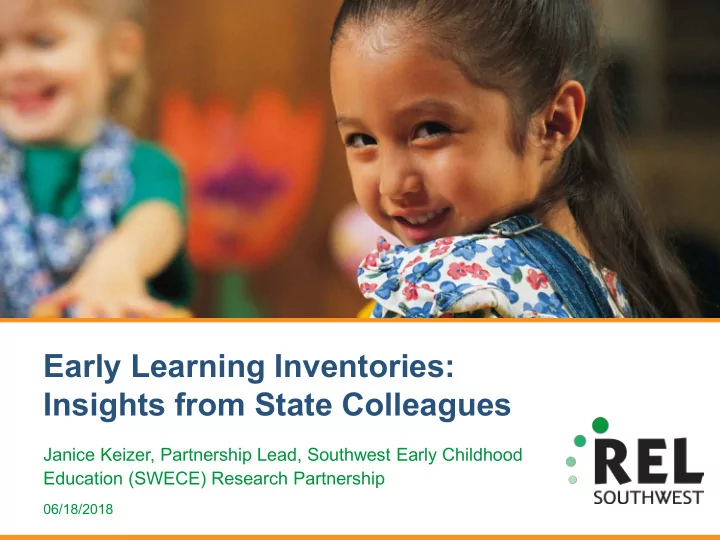

Early Learning Inventories: Insights from State Colleagues Janice Keizer, Partnership Lead, Southwest Early Childhood Education (SWECE) Research Partnership 06/18/2018
Agenda Welcome, Event Orientation, and 1. Speaker Introductions 2. Early Learning Inventories: Overview Facilitated Discussion With State 3. Leaders on Early Learning Inventories 4. Thank You and Stakeholder Feedback
Meet the Presenters • Eboni Howard, Ph.D., Managing Researcher, REL Southwest • Serene Yee, Education Program Consultant, Early Education and Support Division, California Department of Education • Joe Manley, Kindergarten Observation Tool (KOT) Coordinator, Central Regional Cooperative, New Mexico Public Education Department • Mary Anne Olley, Early Educator Advisor II, Commonwealth of Pennsylvania
How does REL Southwest do this work? REL Southwest conducts its work through collaborative research partnerships with stakeholders in Arkansas, Louisiana, New Mexico, Oklahoma, and Texas. To address the priorities and interests of these states, REL Southwest supports six collaborative research partnerships.
Research Partnerships College and Career Readiness Early Childhood Education English Learners Networked Improvement Communities School Improvement Teacher Preparation and Professional Development
Today’s Goal To provide participants with information about how three states selected and implemented early learning inventories (aka kindergarten entry assessments).
Bridge Event Outcomes 1. Gain a better understanding of the different early learning inventories that are available; 2. Increase participants’ knowledge of the benefits, barriers, and challenges of the different early learning inventories; 3. Become aware of the teacher professional development and other training requirements to implement selected early learning inventories; and 4. Gain an understanding of the research on the use of early learning inventories to support student growth and learning.
Closed Captioning by Caption First Below are tips for customizing the closed captioning box at the bottom of your screen: • On the far left: select font type, color, and size • In the center, click the small arrow to hide the formatting choices and see more lines of captioning • On the right, be sure “Auto-Scroll” is checked so the captioning will automatically scroll in real time. • On the right there is also a word search feature
Early Learning Inventories: An Overview Eboni Howard, Ph.D., Managing Researcher, REL Southwest 6 / 18 / 18
Early Learning Inventories (ELIs): Assess when, what, why, for whom, and how ?
ELIs: Assess When? • An assessment is conducted prior to, at the start of, and during kindergarten. • Nearly all states have considered, developed, and/or implemented an early learning inventory, assessment, or profile. − Kindergarten Entry Assessment or Readiness Assessment − Kindergarten Inventory or Early Learning Inventory − Kindergarten Entry, Developmental Profile, other • Kindergarten mandatory or voluntary status of tool varies. − 21 states are mandatory. − 10 states are voluntary. − 9 states unknown, mixed. − 10 states don’t have one selected or are exploring. As of March, 2017 (Grafwallner, 2017).
ELIs: Assess What? • Many aim to cover a range of child developmental domains such as: − Physical well-being and motor development − Social−emotional development − Approaches toward learning − Language and literacy** − Cognitive skills, including mathematics** • The ability of these tools to cover all these domains, with validity, is a concern.
ELIs: Assess Why? • Important to be clear about the purpose of the tool. • States may have mixed or multiple purposes for their tool. − Screen : To identify groups of students who may have particular education needs − Diagnostic : To identify children in need of specialized services or interventions − Benchmark : To track and compare students across programs, schools, districts − Snapshot : To determine students that meet specified performance standards − Document : To guide program-, classroom-, or student-level instruction − Evaluate : To determine and explain the impact of a program or service
ELIs: Assess for Whom? • Multiple purposes = multiple audiences − Families − Teachers and assistant teachers − Principals, school administrators, and school leaders − Policymakers − Advocates
ELIs: Asses How? • Stakeholder input and buy-in • Validation studies • Professional development • Reporting
ELIs: The Challenges • Communicating the intended purposes of the tool • Implementing a continuous improvement process • Lowering burden of using tool • Training and providing professional development • Consistent administration • Using with special populations • Using data • Engaging parents
ELIs: Insights From State Colleagues • What tool has been used? • Why has that tool been used? • For whom has that tool been used? • How has that tool been implemented?
ELIs: Insights From State Colleagues • Serene Yee, Education Program Consultant, Early Education and Support Division, California Department of Education • Joe Manley, Kindergarten Observation Tool (KOT) Coordinator, Central Regional Cooperative, New Mexico Public Education Department • Mary Anne Olley, Early Educator Advisor II, Commonwealth of Pennsylvania
References Howard, E. et al. (2017). Evidence-Based Kindergarten Entry Inventory for the Commonwealth: A Journey of Ongoing Improvement. American Institutes for Research, Washington, DC. Howard, E. (2011). Moving forward with kindergarten assessment efforts: A position paper of the Early Childhood Education Assessment Consortium of the State Collaboratives on Assessment and Student Standards . Washington DC: Council of Chief State School Officers. Retrieved from https://eric.ed.gov/?id=ED543310 National Research Council. (2008). Early Childhood Assessment: Why, What, and How? Committee on Developmental Outcomes and Assessments for Young Children, Catherine E. Snow and Susan B. Van Hemel, editors. Board on Children, Youth and Families, Board on Testing and Assessment, Division of Behavioral and Social Sciences and Education. Washington, DC: The National Academies Press. Schilder, D. and Dahlin, M. (2017). Key Considerations to Assist States in Developing or Revising a Kindergarten Entry Assessment (KEA). New Brunswick, NJ: Center on Enhancing Early Learning Outcomes (CEELO). http://ceelo.org/wp-content/uploads/2017/12/ceelo_kea_key_questions_development_12_2017.pdf U.S. Department of Education, Office of Planning, Evaluation and Policy Development, Policy and Program Studies Service. (2016). Case Studies of the Early Implementation of Kindergarten Entry Assessments Final Report. U.S. Department of Education. Washington, D.C. http://www2.ed.gov/about/offices/list/opepd/ppss/reports.html. Weisenfeld, G. (2017). Assessment tools used in kindergarten entry assessments (CEELO FastFact). New Brunswick, NJ: Center on Enhancing Early Learning Outcomes. http://ceelo.org/wp- content/uploads/2017/01/ceelo_fast_fact_kea_state_scan_2017_01_for_web.pdf
Questions?
Contact Eboni Howard, Ph.D. 312-588-7339 ehoward@air.org
Recommend
More recommend